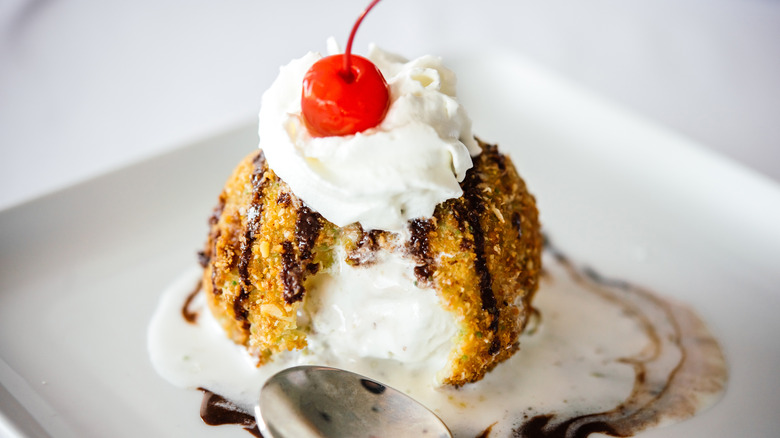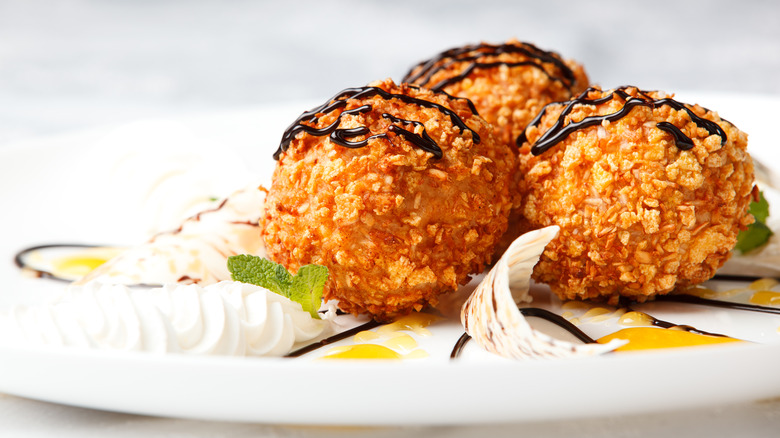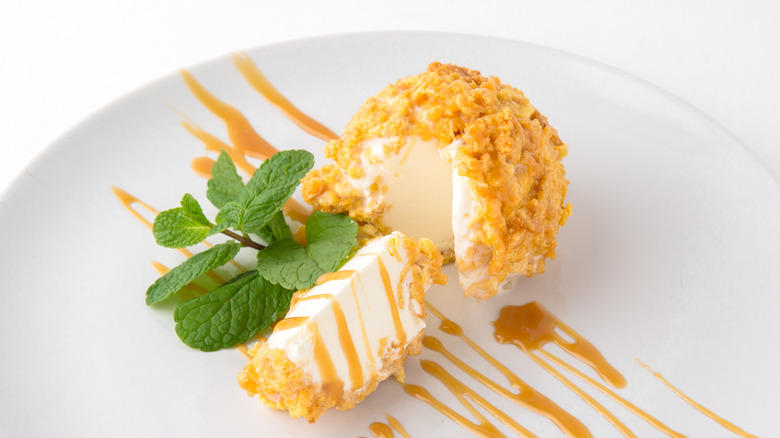Why Fried Ice Cream Doesn't Melt
If you've ever eaten ice cream on a hot summer day, you know that you have to be quick about it or else it'll melt all over your hand. Fried ice cream, on the other hand, is a different story. Even after it gets deep fried in hot oil, the ice cream still manages to maintain its integrity. So how is this possible considering ice cream is so sensitive to heat? The answer lies in ice cream's melting point.
In order to remain solid, ice cream must be kept at 0 degrees Fahrenheit. Of course, as soon as it hits 32 degrees Fahrenheit, it starts to melt. As long as you keep its temperature under 32 degrees, it'll stay in its solid state. The key to accomplishing this is to get the ice cream extra cold, so cold that it's not just frozen, but hard. This can be done in a commercial freezer, which can reach temperatures as low as -20 degrees Fahrenheit, according to manufacturer Ancaster Food Equipment, or at home by freezing individual ice cream balls on a metal baking tray overnight.
The batter isn't just there for taste
Using frozen solid ice cream helps prevent it from melting into a puddle, but it doesn't completely offset the heat from the frying oil. The batter also plays a role. Fried ice cream is first coated in egg whites and sugar, then rolled in panko, cereal, or coconut flakes. The combination of these ingredients and the thickness of the coating insulates the ice cream to help prevent it from melting.
While other fried foods typically use a flour-based batter, there's an important reason fried ice cream calls for egg whites instead. Egg whites can be whisked into fluffy, light mounds because they are excellent at trapping air when you whisk them, and these tiny pockets of air don't transfer heat well. This allows the coating to act as an insulator, similar to when you make a baked Alaska, in which ice cream and cake are coated in a meringue and baked in the oven.
For their last trick, egg whites also have a consistency that bread crumbs and cereal crumbs can easily stick to, which helps create a thick coating around the ice cream, sealing it off from direct contact with the oil.
A more foolproof way to make fried ice cream
Fried ice cream isn't exactly the easiest dessert to make at home, especially considering the coating and temperature have to be just right. Even something as simple as making your ice cream scoops too small can result in the heat getting the best of your creation. If all this sounds too difficult for you, try preparing the coating and the ice cream separately and combining them at the end. The result is much more foolproof although slightly less visually impressive. Technically, the only fried part of fried ice cream is the coating, not the ice cream itself, anyway.
Instead of making a batter, toast coconut flakes, sugar, and cereal crumbs in a skillet along with some butter. This makes up the "fried" layer. Once cooled, you can then roll each ball of ice cream in it until fully coated. Though the ice cream won't be encased in a fully intact shell, it'll still produce a similar flavor and look without you having to worry about it melting in the process.


